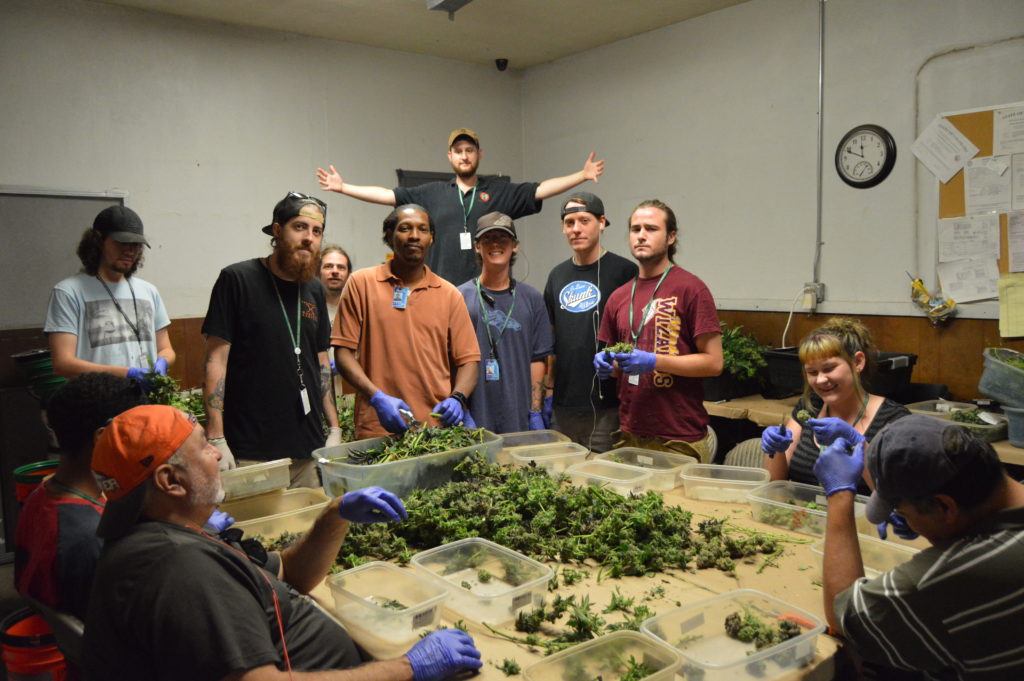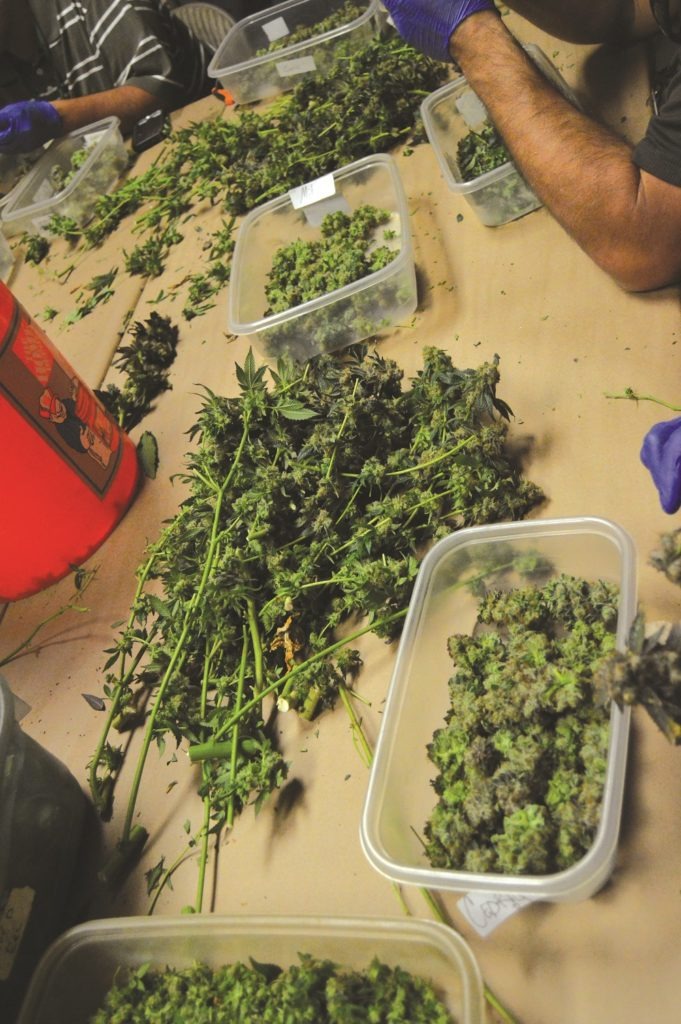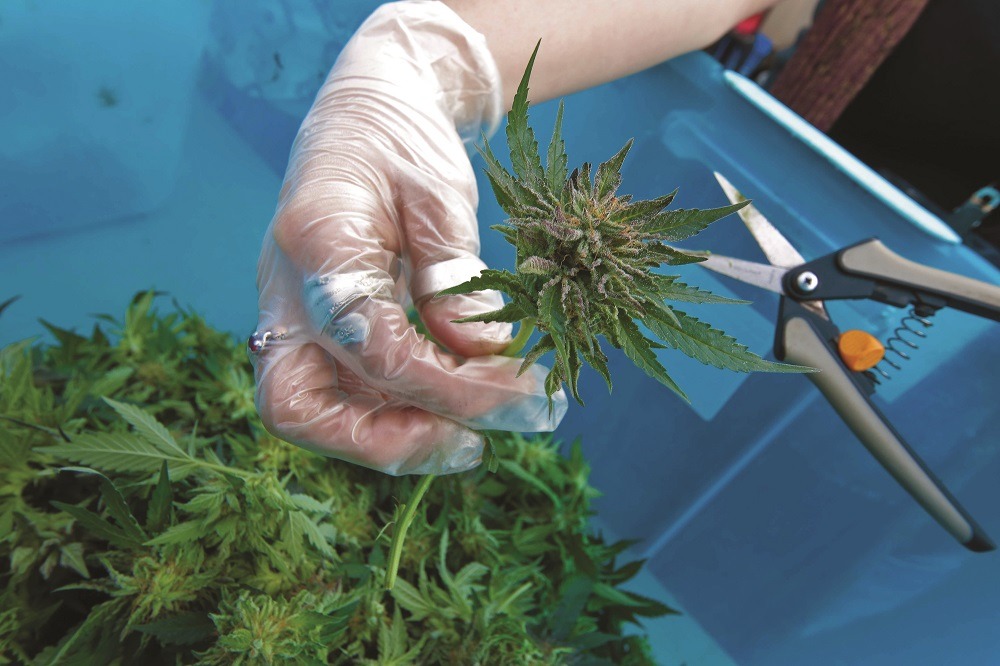Harvest for Hire
Professional trimming crews can help producers and processors limit labor costs, one of the biggest operating expenses for a commercial facility
By Garrett Rudolph
Most people in the cannabis industry would agree: Trimming sucks.
It’s sticky, tedious and time-consuming. It’s exhausting, both physically and mentally, and it’s a race against the clock as one of the last major tasks required before sending finished product to the market.
For growers, the trimming process can be one of the single biggest profit-killers. Commercial operations typically require an awful lot of manpower or horsepower to get the job done efficiently.
But as the legal cannabis industry matures, more and more companies are looking at specialization as a way to cut costs and run a tighter ship. Outsourcing can allow growers to focus more of their energy on growing their bottom line.
Manpower
In 2010, Susan Chicovsky was exploring avenues to get into Colorado’s cannabis industry. A serial entrepreneur and self-proclaimed healer, she originally considered opening a dispensary.
But dispensaries and grow facilities were popping up everywhere, and Chicovsky elected not to follow the crowd. Instead, she launched Green Mountain Harvest to provide trimming and consulting services to rapidly expanding commercial growers.
And business has been booming.
The need for efficient trimming services was recognized quickly by the Colorado cannabis industry, and Green Mountain Harvest has been expanding to Washington, Oregon, California and Nevada. It could be national or even international within a couple years, Chicovsky predicts.
Green Mountain Harvest generated about $250,000 in revenue in its first year of operation, and the company has doubled that almost each year following.
What started as Chicovsky and four trimmers has ballooned into a 96-person staff.
“The only downside for me as a healer is that we’ve had to become a bit more corporate than I ever anticipated,” Chicovsky says. “We have people around the country interested in becoming part of our organization.”
Grow operations hire Green Mountain to provide professionally-trained trimmers, whether they need a couple extra hands at a particular time during harvest or an entire crew for a perpetual cycle.
Green Mountain tailors its services to the needs of its clients. Trimmers are available seven days a week, and they all wear gloves and clean clothes, bring an OSHA-cleared tool box and have the paperwork to back up the company’s established best practices. Employees are trained for both wet and dry trimming. While Chicovsky prefers dry trimming, she says her customers are split 50-50 between wet and dry.
Trimmers are required to finish one pound (453 grams) of dried cannabis per day or 3,000 grams of wet. Many trimmers are capable of finishing 5,000 to 7,000 grams of wet cannabis per day, Chicovsky says. The estimated cost to the grower is between $150 and $225 per pound, she says.
Green Mountain employees can also provide any other support services the growers might need, ranging from clean-up to joint rolling.
It’s kind of a one-stop shop for anybody in the marijuana world who needs workers.
“We really run a professional company that’s reliable,” Chicovsky says.
The company has grown so fast because all growers need to trim, and it’s such a time-consuming part of the operation, Chicovsky says.
Most growers start with their own in-house trim crews, but they get tired of dealing with personnel issues and the additional costs of having more on-staff employees. Green Mountain eliminates some of the hassles by handling all the hiring, firing, payroll, accounting and supervision. The company only hires trimmers with at least six months of experience working in a commercial facility, which ensures the clients aren’t paying for a learning curve.
Chicovsky has had to learn how to bid a job, to make sure it’s both cost-effective for the client and profitable for her business.
To that end, she also has a simple rule for her trimmers: You talk while you trim, or you don’t talk at all.
Horsepower
Sean Green started a similar business with a different approach.
In 2015, he launched Everything Harvest, a company that provides commercial trimming services to large-scale growers on the West Coast. When Green shows up at a grow site, he brings a crew and a small army of machines capable of trimming more than 100 pounds of cannabis per day.
The Spokane, Washington-based entrepreneur was the first person in the state to get a marijuana business license. His company, Kouchlock Productions, received a Tier 3 producer/processor license in March of 2014.
The idea for Everything Harvest evolved directly from the processing needs of Kouchlock.
“I had a whole bunch of pot to trim,” Green says, “and I figured everybody else did too.”
Everything Harvest puts a premium on speed and efficiency.
“From the day you cut a plant down, it starts to degrade,” Green says.
Using multiple trimming machines and well-trained operators allow growers to have salable product much faster. Green says he’s trimmed up to 175 pounds in one day using three machines.
By speeding up the trimming process, indoor growers require less time to transition from harvest to market. For outdoor growers, trimming services might be even more valuable by giving them the ability to put product on shelves before the seasonal price drop takes effect.
Green’s crew is full independent; they bring a generator and all the necessary equipment to work from the middle of a field, if necessary.
Everything Harvest serves clients in Washington, Oregon and California, and the clients receive 100% of the product, which avoids problems with traceability requirements.
Just like other trimming services, Everything Harvest helps reduce the need for growers to keep a large full-time staff. Green says he brings $40,000 worth of equipment to job sites, so growers can also avoid the capital investment of multiple trimming machines and the labor hours required to learn how to operate the machines.
Green is also planning on setting up a Harvest Everything retail store that will sell and lease equipment, in addition to providing trimming services.
Man versus Machine
There’s a significant debate within the cannabis industry about the merits of hand-trimming versus machine-trimming.
As one would imagine, Susan Chicovsky and Sean Green have opposing views on the subject.
Green favors the efficiency of machine-trimming. It’s about the sheer numbers: In order to trim 100 pounds of marijuana in one day, you’ll either need 100 people or you’ll need a couple machines. Green says any initial hesitation he’s encountered from growers has evaporated once they realize how much time can be saved.
Machines need to be cleaned regularly, but they don’t lose energy throughout the day. They don’t require a minimum wage, unemployment insurance or workers’ compensation.
Plus, “my machines don’t take lunch breaks,” Green says.
He remembers the days of locking himself in a house for three weeks at a time and going to town on a freshly-harvested crop with a pair of scissors.
“It was the most excruciating thing I’ve ever done,” he says. “Somehow through all that, I became a professional trimmer, as it were, and came to enjoy the process of efficiency.”
Meanwhile, Chicovsky believes the quality of the finished product is much higher when hand-trimmed.
She says there are times when a machine is valuable and makes sense from a financial perspective.
But the human touch allows trimmers to cater more to the wants of growers. Some growers want each strain to be trimmed differently, requiring a level of precision machines simply can’t match, she says.
Green says there’s more of a learning curve than people realize when it comes to operating trimming machines. Quality and efficiency are directly related to how well-maintained the machine is and how experienced the operator is.
“If you used a machine once, you didn’t know how to use it,” he says. “It takes a few days of running one of these machines to know the sounds, the tweaks, the tunes, when to clean it, why to clean it.”
The quality and consistency also varies from machine to machine. Some are certainly better than others, Green says.
It remains to be seen what role consumer preference will play in the man versus machine argument when it comes to trimming. Most say they want the perfectly manicured buds associated with hand-trimming, and many wholesale buyers say well-trimmed product is essential when they’re looking at bringing a new vendor into the fold (see the December issue of Marijuana Venture for more details).
But can anybody actually tell the difference between the two methods? And if consumers can save a few bucks per gram on machine-trimmed product, will that sway their selection?
Training
Getting a job in the cannabis industry can be challenging.
It’s the classic conundrum that makes nearly every job hunter cringe: In order to get a job, you need experience; in order to get experience, you need a job.
Cannabis retail stores and grow operations often get hundreds of applicants when they have openings for budtenders or trimmers, which allows them to be highly selective. Even Green Mountain Harvest requires six months of commercial trimming experience to be considered for its full-time team.
Chicovsky says about two years ago she started seeing an influx of people who wanted to be trimmers but had no experience. That prompted Green Mountain to start a trimmer training school.
The training program is designed to teach people the finer points of working in a commercial cultivation facility, including techniques for both wet and dry trimming and best practices for working in a grow environment.
In addition, Green Mountain Harvest offers on-site training courses, where the company brings its expertise directly to growers throughout the country. Upon completion, trainees receive a certificate to prove they’ve been taught the necessary skills.
Money Matters
Employee costs can easily be one of the most overlooked expenses for any company.
It’s not just the repetitive and time-consuming act of clipping away excess fan leaves with scissors that makes trimming so expensive for commercial grow operations. Marijuana trimmers — just like employees of traditional businesses — come with a multitude of additional costs for companies.
These extra expenses can be particularly shocking for those transitioning from the black market — where employees were often paid in trade — to the highly-regulated, highly-taxed legal realm.
Dan S. Kennedy, author of “No B.S. Ruthless Management of People & Profits,” wrote that a $12 an hour employee truly costs a company almost $16 an hour when taxes, Social Security, unemployment insurance and workers’ compensation are factored into the equation.
In an excerpt published by Entrepreneur, Kennedy tallied all the ancillary costs of employees: hiring and firing, training, internal theft, mistakes that cost the company money, health care coverage, retirement packages, bonuses and necessary equipment.
In his hypothetical circumstance, he conceived that $12 an hour workers could cost their employees more than $36 an hour. That’s where outsourcing a task like trimming could be advantageous for a commercial operation.
Chicovsky says the cost to hire Green Mountain Harvest is slightly higher than the wages an operation would pay for its own employees.
“However, the time savings are tremendous,” she says, when taking into account additional expenses, opportunity costs and the energy dedicated to human resources.
“Plus, most people don’t want the job,” Green adds regarding trimming.





